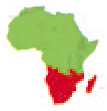DK People & Places: Southern Africa
This part of Africa has a narrow coastal plain running up to a ridge of hills surrounding a huge central plateau of high land. The eastern coast is subtropical; the south has a Mediterranean-style climate, where fruit and other crops can be grown; and the interior is desert or dry grassland. South Africa is highly industrialized and there are large mineral mines in Namibia and Zambia.
Only one tribe lives in this desert, which covers much of Botswana, Namibia, and northwest South Africa and is one of the most inhospitable places on Earth. The San people have managed to live here for thousands of years by searching for their food instead of growing it. People, plants, and wildlife must be able to withstand drought conditions for up to ten months of the year.
The national borders of some African nations follow natural features, such as rivers and lakes, but many were drawn as straight lines on maps by the European nations who divided Africa between them in the late 19th century. As a result, many African peoples are split between several countries and do not feel part of any of them. This has caused great unrest and even civil war in some areas.
Vast deposits of gold and diamonds were first found in South Africa in the late 19th century and have made the country rich. One-third of the world’s gold is still produced in the Witwatersrand gold field around Johannesburg. Its neighboring country Namibia is also rich in diamonds and other minerals, such as copper and tin. In fact, minerals make up 90 percent of Namibia’s total income from exports.
The South African national rugby team is named after the springbok, a fast-running local antelope. Rugby is one of the two national games of South Africa, with cricket also attracting a large following. Under apartheid, the national rugby team was all-white. Today, the team is multiracial and has huge support from all South Africans.
The word apartheid means “apartness” in the Afrikaans language. It was a policy introduced in South Africa by the government (in which only white people were allowed to participate) in 1948 that said that black and white people must live and work separately. It caused great hardship to black people and was widely condemned. Apartheid was abolished in 1994 when South Africa became a multiracial state.
The end of apartheid in South Africa has led to huge changes in the region. Although the old conflict between black and white peoples has been replaced by a desire to work together, poverty, violence, and high crime rates are widespread. With thousands of people currently dying each day from AIDS, many families are left without a main earner.
Capital city: Luanda
Population: 13.9 million
Official language: Portuguese
Major religion: Roman Catholic
Capital city: Windhoek
Population: 1.8 million
Official language: English
Major religion: Christian
Capital city: Pretoria; Cape Town; Bloemfontein
Population: 44.2 million
Official languages: Afrikaans, English, and African dialects
Major religion: Various
Capital city: Gaborone
Population: 1.6 million
Official language: English
Major religion: Traditional beliefs
Capital city: Lusaka
Population: 10.9 million
Official language: English
Major religion: Christian
Capital city: Harare
Population: 13.1 million
Official language: English
Major religion: Syncretic (Christian/Traditional beliefs)
Capital city: Maseru
Population: 2.1 million
Official languages: English and Sesotho
Major religion: Christian
Capital city: Mbabane
Population: 948,000
Official languages: English and Siswati
Major religion: Christian
Capital city: Maputo
Population: 19 million
Official language: Portuguese
Major religion: Traditional beliefs
Capital city: Lilongwe
Population: 11.8 million
Official language: English
Major religion: Protestant
Capital city: Moroni
Population: 749,000
Official language: Arabic, French
Major religion: Muslim

